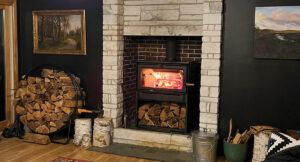 Well, the answer is none unless the air has a way to get out of the bottle. You have probably never been asked that question before, and you may be wondering what that has to do with energy efficiency. The answer is simple – understanding the basics of airflow can help you understand an important aspect of home comfort.
Well, the answer is none unless the air has a way to get out of the bottle. You have probably never been asked that question before, and you may be wondering what that has to do with energy efficiency. The answer is simple – understanding the basics of airflow can help you understand an important aspect of home comfort.
An example is the wood-burning fireplace. An equal amount of incoming air must replace the amount of warm air that is moving up and out of the chimney. The replacement air may be coming from other rooms within the home, plumbing and electrical penetrations, from around switch and outlet covers, attic access doors, poorly sealed doors and windows, and from numerous unsuspecting sources of air infiltration. That’s why a home heated with a wood-burning fireplace usually is cozy near the heat source and chilly in the surrounding rooms.
Understanding the nature of airflow can help you improve the comfort within your home and lower your utility bill. Folks often ask if it is beneficial to close off rooms that are not regularly occupied. Usually they are referring to closing the supply-air registers and the entry doors into those unoccupied rooms. I understand the idea seems logical, but the answer is almost always “no.” Closing off the air supplies and doorways are almost always detrimental to energy savings and comfort. That statement usually catches most peoples’ attention. “How can this be Doug?” they ask.
A properly installed forced-air heating and cooling system is designed for balance. A balanced system will efficiently deliver the proper amount of airflow and the desired temperature into every room within a home.
Here’s what can happen when changes are made to a balanced system. Suppose the supply-air registers and doors in two unoccupied rooms are closed. Now the overall heated and cooled living space has been reduced. This manmade circumstance just created a situation where the heating and cooling unit is now oversized, instead of properly sized.
Additional laws of unintended consequences develop, such as reduced compressor life, higher duct pressures and potential for greater duct leakage, additional burden on the air-handler and the likelihood of mold and mildew developing in the unconditioned rooms. The unit may also run for very short periods of time, causing humidity levels to climb and comfort to be diminished.
Also, if you have natural gas or propane appliances, closing off rooms can be very dangerous from an indoor air quality perspective. Carbon monoxide can be back-drafted from water heater and furnace flues under certain situations.
The closed-off rooms represent a soda bottle. Air cannot move through the room and back into the return-air grille when supply-air grilles and doors are closed. Now, let’s open the registers in these same two rooms, but leave the doors closed. No more air can blow into the rooms than can escape out of the rooms. For example, if the doors are touching the carpet and the rooms are airtight,

info@philliprye.com, or call 501-653-7931.
almost no air can enter the room. If the door is tight and air still comes in the rooms, you know there are leaks in the building envelope. In other words, the money you just spent to heat or cool just leaked to the outside.
We’ve tested many homes that were hot in the summer and cold in the winter only when the doors were closed. Properly trimming the bottom of a door to create a 1-inch air gap or installing a return-air grille in the door will often solve this problem. In conclusion, it is nearly always best to leave all registers and doors open. If you have questions, you may call my office 501-653-7931. I will be happy to help you.







